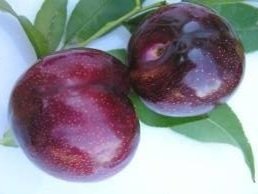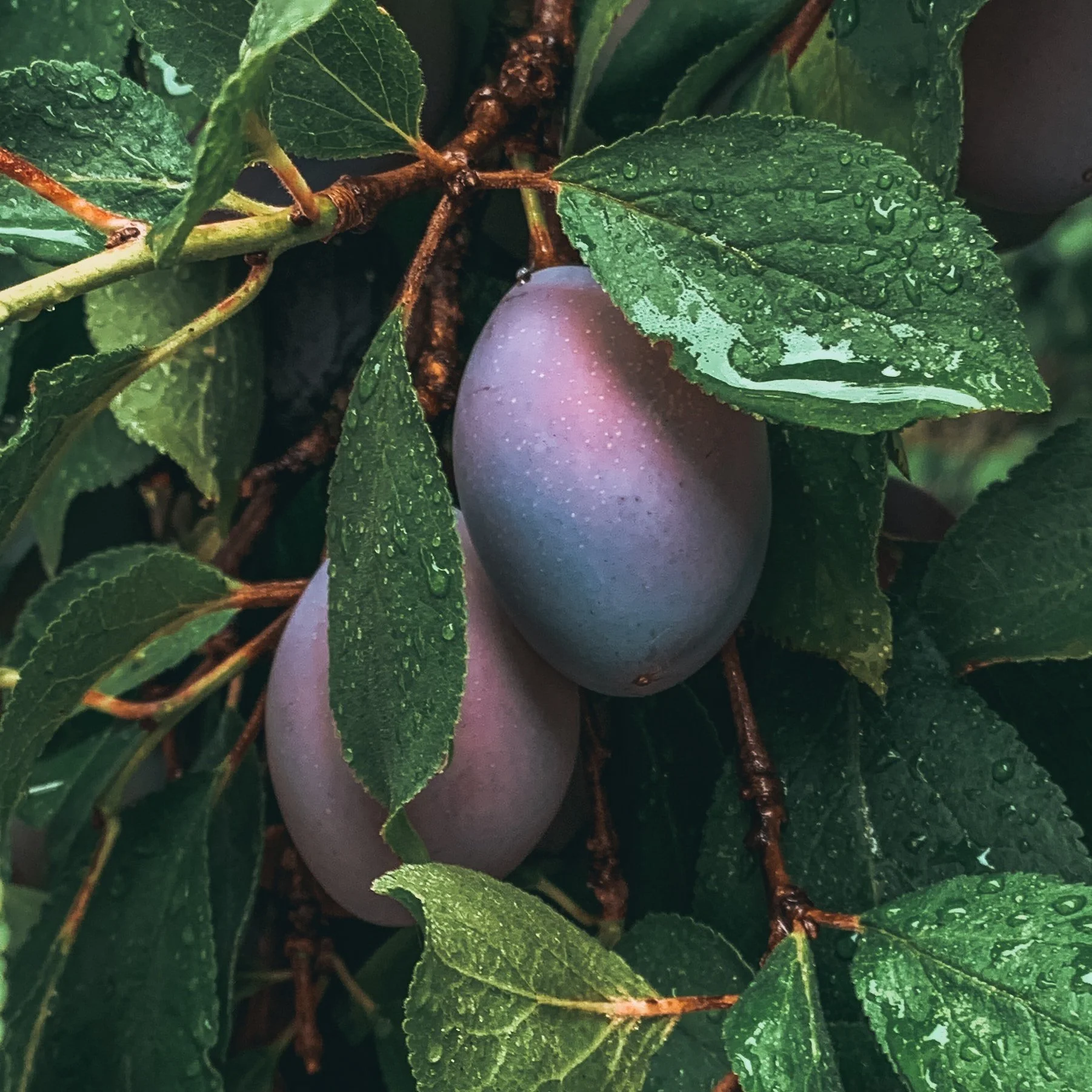Plum Trees
Commercially grown plums in the U.S. are the descendants of Asian rootstocks first introduced in the Central Valley in the 1870s by Luther Burbank. Burbank brought the Japanese trees here and planted them on his farm in Santa Rosa where they flourished. Today, through crossbreeding there are several modern plum varieties in various sizes and colors including red, yellow, purple, green, blue and black.
California produces the lion’s share of the commercial plum crop accounting for approximately 90% of the total U.S. production. In addition to more than two hundred varieties that ripen at different times during the peak summer season, a select few ripen into the fall.
Plum Tree Rootstocks
We offer you a choice of 22 varieties of Nectarines on these rootstocks.
Citation, Flordaguard, Nemared, Lovell, M-40, Controller 5 (PP#15,228), Controller 9 (PP#15,225), Marianna 26-24, Myobalan 29C, Guardian® Brand (BY520-9)
Burchell Nursery provides its customers with the utmost planting flexibility by offering most varieties as Ready Start® Potted Trees. Please consult with your field reps for Healthy Start Trees’ current availability and pricing.
Plum Varieties
-

Angeleno
Seedling of Queen Anne. Tree is spreading and can be excessively vigorous. Fruit is oblate, medium size with dark purple to nearly ebony skin. Flesh is amber color with mild slightly sweet flavor and good firmness. Santa Rosa and Wickson are pollinators.
Ripens September 5–15
-

Blackamber
USDA release. Blackamber is a cross between Queen Rosa and Friar. Fruit tends to be very large, oblate, with black skin and amber flesh. Firmness is good but quality meager at shipping maturity. Tree growth is upright with adequate vigor. Variety can tend to alternate bear. Amber and Catalina have been used as pollinators.
Ripens June 22–July 1
-

Black Splendor
Black Splendor is a USDA release with a medium to large size fruit and a blue/black skin color. The flesh is red to dark red with better firmness than Santa Rosa. Harvest time is early June, which is earlier than Santa Rosa. It is a clingstone variety and a very good producer.
Ripens early June
-

Burbank
This winning Japanese-type plum almost has the color of a nectarine, with red blushing over a yellow background, with golden-orange flesh that is sweet and quite juicy. Dramatic spring blooms are pristine white against dark green foliage. A hardy tree that is easy to grow and produces a large crop for fresh eating, fruit tarts, jams and jellies. The only thing birds like more than plums are mulberries, so plant one of those nearby. Introduced in 1897 by the American Pomological Society, and named in honor of Burbank for his exemplary work with plum crosses.
Ripens in mid-July.
-

Burgundy
The Burgundy Plum is an exciting versatile plum that is not only great tasting, harvests over a long period, but also is one of the best pollinators for your other plum varieties. Named for it’s deep dark red flesh like no other. the self-fruitful Burgundy plum has burgundy-colored skin, is a semi-freestone, with sweet dark red burgundy flesh with little or no tartness. This fruit eats well early when the flesh first turns red. At this time the fruit is firm with a great snap and crunch with a slight bite to the skin. Ripening over a 2 month period the fruit continues to improve in sweetness, the bite to the skin goes away and the fruits unique mild flavor grows. This is a top taste test winner in numerous test conducted over the years. Burgundy is an all-purpose home garden plum, delicious for fresh eating, cooking, drying and in jams and jellies. Burgundy has also proven to be one of the best pollinators for other Japanese plums and most all Pluots
-

Caramel Kiss
This is one Special early season plum. The Caramel Kiss is a perfect sprightly plum with a rich sweet flavor. The acid brings out a unique flavor not common to early season fruit outside of the plum apricot crosses. But the Caramel Kiss is just one simply delightful flavored fruit. You’ll love the size of the fruit as well not to big that won’t enjoy a few at each opportunity. Its small to medium size fruit with a copper-colored skin and rich orange-red flesh is eye candy as well. An early season treat that’s sweet and juicy and begins its long harvest period in Mid June when it is picked firm and crunchy. Let it hang on the tree until mid July and you have a juice running down your arm intense flavored fruit just dripping with sweetness.
-

Casselman
Bud mutation of Late Santa Rosa. Fruit is round, firm, stores well and has good quality. Skin is a light red color with orangish–yellow flesh. Fruit has a tendency to crack on stem end, particularly if subjected to rain.
Ripens August 1–10
-

Catalina
A purported seedling of Angeleno with very good eating quality and firmness. Fruit is of medium size and somewhat squatty in shape. Dark purple skin with amber yellowish fruit. Tree is intermediate and spreading with good vigor. Blackamber, Angeleno and Santa Rosa have been used as pollinators.
Ripens July 1–5
-

Dapple Dandy Plumcot
Prunus Interspecific Hybrid ‘Dapple Dandy’One of the original Plum-Apricot crosses from the world Famous Floyd Zaiger and Zaiger Genetics. Large and full of flavor, the Dapple Dandy is also one of the most dependable plum apricot producers and easy to pollinate. A freestone cross that is blushed cream white and red flesh. This fruit has a truly fabulous apricot plum flavor. The winner of many fruit tastings, Dapple Dandy’s skin is deep green with spots of red turning a maroon with dappled yellow spots as it matures. Also known as the Dinosaurs Egg, it was one of the first of the Plum apricots available in the grocery store. A mid season ripening variety, it is the perfect companion to other Plum Apricot varieties like Flavor Queen, or Flavor King or the late season Flavor Grenade. Also is great when paired with plums or Apricots. Santa Rosa plum and the Burgundy plum are both idea pollinators.
-

Elephant Heart
This very large plum has blood red skin and red flesh of excellent flavor. The Elephant Heart plum needs a pollinizer to set heavy crops. One of the best plums in the world.
Ripens in August to September
-

Emerald Beaut
Emerald Beaut plum will amaze you with the many different ways you will enjoy eating it. A long season ripening plum that comes ready, firm and crunchy sweet in mid August. Hanging on the tree only improves its super sweet honey like flavor. Not done until the last one is picked, by November the fruit is syrupy sweet almost too sweet for some. But oh the crunch never leaves this special piece of fruit. Emerald Beaut is a late flowering variety requires a late or long flowering variety to pair it with. Try the long blooming Burgundy plum or the late flowering Burbank plum to compliment your Emerald Beaut.
-

Flavor Delight Plumcot
….
-

Flavor Grenade Plumcot
One of the most explosive flavors one can ever experience! A literal burst of sugary sweetness mixed with an almost tropical finish. The long hang time of the Flavor Grenade Plumcot is another rare treat. Start harvesting in Mid August in zone 9, when the fruit is just hitting its high sugar content and experience a delightful crunchy goodness. The trees heavy cropping will not allow you to eat them all so the fruit hangs just getting sweeter and sweeter into late October and November. That is if they last that long. The true uniqueness of the Flavor Grenade is the crunchy firmness remains a part of the eating experience until the last piece of fruit is eaten. Fruit is greenish with a red Blush and the flesh is yellow. Very easy to pollinate with another Japanese plum variety or another Plum-cot selection
-

Flavor King Plumcot
Another of the original plumcot introductions from world famous Floyd Zaiger. The Flavor king is a uniquely flavored fruit which brings out the best of the plum and apricot that make up its parentage. The fruit is first distinguished by its incredible aroma. Cut open a Flavor King and the room fills with the sent of a bouquet of flowers. Bite into the Flavor King and the bouquet fills your mouth with a complex flavor palate that is rich and sweet. Flavor king has reddish-purple skin, sweet Yellow/red flesh. It is the perfect companion for other plumcot selections like the Flavor Supreme and the Flavor Grenade plumcots which are also good pollinators. The Flavor King also pairs well with great plum varieties like the Burgundy and Santa Rosa Plum. Along with it beautiful spring floral display, this is truly one of the finest fruit introductions to the home garden.
-

Flavor Queen Plumcot
The Flavor Queen Plumcot was one of the first introduced by the world famous hybridist Floyd Zaiger. Large green with green skin when first ripe turning to a blushed yellow as it gets syrupy sweet. Tasting this gems leaves no wonder why it catapulted the Plumcot to worldwide notoriety. The flesh is a light amber orange almost melon like. A mid season ripening variety the Flavor Queen has a long hang time often eating well for over a month. Only getting better and better, sweeter and sweeter. Pair this royalty with the Dapple Dandy or the Flavor Supreme, but sorry it does not work well with the Flavor King,,,,go figure? Also the Burgundy plum works well as a pollinizer as well as the Santa Rosa plum. A fast growing large tree keep the Flavor Queen under 10 feet with summer pruning for size control. This is one for dehydrating, which brings out the intense flavors and intensifies the sugars.
-

Flavor Supreme Plumcot
Flavor Supreme is one of the original plum apricot selections from Zaiger Genetics. Early ripening and so so good, this is another consistent taste test winner. Marbled greenish maroon colored skin with red flesh. This variety eats well from firm ripe to when the juice is running down your arm. The intensely rich sweet taste is as good as it gets in early season fruits.
-

Fortune
USDA release. Large, bright red plum with yellow background where shaded. Fair flavor. Somewhat rounder shape than Friar. Mid-season bloom. Needs pollinator. Santa Rosa and Friar may be suitable.
Ripens July 25–August 2
-

Friar
USDA release. Gaviota X Nubiana. Fruit is oblate, large and firm. Skin color is dark, ebony to black when mature. Flesh is amber, mild with a very small stone. Tree growth is upright and thrifty. Santa Rosa, Laroda, and Blackamber are pollinators.
Ripens July 18–22
-

Green Gage
Green Gage is an heirloom plum variety prized for its exceptional honey taste. Considered by many to be the finest flavored of all European Plums. Small green fruit with translucent greenish-yellow flesh develop red blush when ripe.
-

Honey Lightning
The Honey Lightening will strike your taste buds with a brilliant burst of super sweet juice. It’s a pretty plum, with golden skin blushed by red. A yummy bite reveals soft yellow flesh with an oh-so-nice texture.
-

Italian Plum
….
-

John W
USDA release. Fruit is slightly oval with a medium to large size. The skin is purple-red with speckles and the flesh is orange with a firm texture. The tree blooms late and harvests about August 25. The tree is a good producer with an upright to slighty spreading form.
Ripens August 25
-

July Santa Rosa
A mutation of Santa Rosa. This is one of the better eating plums of the season. Fruit is dark red, somewhat larger and more round than Santa Rosa. Variety is self-fertile and tends to drop fruit from post bloom to harvest. Tree is spreading with moderate vigor. Little thinning is required.
Ripens June 22–25
-

Kelsey
Fruit is large, somewhat heart shaped and often sheep-nosed on blossom end. Skin is greenish yellow and deepens to yellow with maturity. Flesh is yellow. Tree has moderate vigor. Use Wickson as pollinator.
Ripens July 15–20
-

Lavender Showers
When it’s ripe, it rains with juice. Lavender Showers is a reining taste test winner that’s packed with a copious amount of super sweet juice.
-

Laroda
University of California release. Fruit is deep reddish purple with light amber flesh. Round fruit of medium size has very good quality. Pollinated by Santa Rosa.
Ripens July 5–10
-

Mariposa
The Mariposa is a brawny purple red choice that has great tasting blood red flesh. The fruit is large and juicy for fresh eating or cooking. A low-chill plum for mild climates.
-

Methley
Methley is one of the few Japanese plums that are self-fruitful and suited to both low chill and high chill climates. Sweet and Juicy the eating quality is good right off the tree. Setting at an early age and with abundant crops from zone 4 to zone 9. Known for the long hang time, the Methley can be picked over a 4 to 5 week period in most climates.
-

Satsuma
Juicy, red flesh with sweet flavor is great fresh, cooked or canned. The Satsuma Plum can be enjoyed for its red, meaty flesh that is indeed very juicy with a mild sweet taste. You’ll love every sweet drop of flavor whether you eat these plums fresh or make them into luscious jam.
-

Sugar
….
-
Queen Rosa
USDA release. This variety produces large fruit that is of variable color and firmness. Color and firmness are poorest in deep rich soils and/or with high nitrogen levels. Adequate pollinizers should be used, such as Ambra or July Santa Rosa.
Ripens June 21–25
-

Owen T
USDA release with fruit that is oblate and large. The flesh is light yellow, firm with a medium texture. The skin color black with purple shoulders. The tree is self-fertile.
Ripens June 25–July 5
-

Red Beaut
Fred Anderson release. This is the first variety of the season often establishing price and shipment levels for subsequent varieties. Fruit is firm, of medium to small size with nice red color and light amber flesh at maturity. Blossoms are pollen sterile and must use a pollinator. Ambra is a suitable pollinator.
Ripens May 20–25
-

Santa Rosa
A standard of the season both in volume and name recognition. Fruit is medium size, somewhat heart- shaped and can lack firmness during high temperatures. Eating quality is very good although the skin can have an astringent characteristic. Fruit is red skinned. Variety is self-fertile and is often used as a pollinator. Spreading tree of moderate vigor.
Ripens June 12–20
-

Simka
Large dark purple fruit is fairly round with somewhat pointed apex. Flesh is yellowish-white, quite firm and of fair quality. Tree is vigorous and spreading and is self-fertile.
Ripens July 10–20
-

Toka
Toka plum is one of the most exciting of the cold hardy American plum varieties. Dependably sets fruit in South Dakota where is was developed and introduced in 1911. Medium to large fruit that eats well from firm to soft ripe and just keeps getting sweeter. Unique aromatic yellow flesh is complex with fruity mixtures of flavors, hence its nick name Bubble Gum Plum.
-

Wickson
Big, yellow plum with pink tip when perfect. Very low in acid. Eats like a peach. Dries well.
Ripens late June
Ripening dates shown are approximate for Fresno in California and may vary with season and location.



